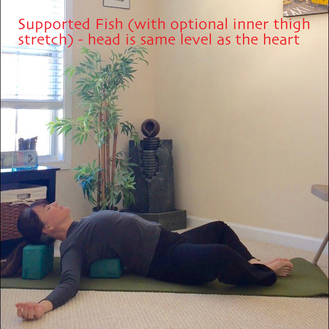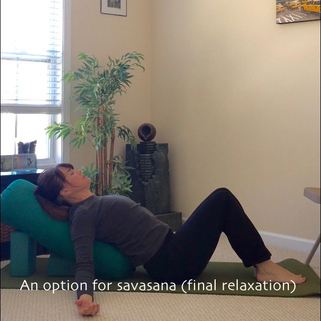|
Here are some tips for those of you who might already practice yoga but find it occasionally makes you dizzy or brings about a vertigo episode. There are some things you can do while practicing that may help you fend off the dizzy or avoid the episode. First – as with any yoga practice – stay present and really tune in to your body. If something isn’t working for you – there is NO reason to continue to do it. Practice with a lot of space around you in case you stumble or fall (near a wall is helpful). First of all, pick your classes carefully. Know that there may be days where a hatha or vinyasa yoga class is just not appropriate for you, as much as that might disappoint you. Trust me, I’ve been there! Maybe a gentle, restorative, or a deep stretch class would be better on that day. Hot yoga? I can’t imagine hot yoga working well for someone with a vestibular disorder so I would proceed with caution there, but again, if it works for you, go for it. Learn to tune in to your body and your vestibular system while practicing. Honor both every time you step on your mat. Begin to find your limits and modifications and learn to live within them, making peace with what life has given you. And celebrate with so much gratitude those days when you are well enough to do ANY practice. Modify. Modify. Modify. That’s going to be your mantra for your practice right now. For example, if you find that camel pose (ustrasana) makes you dizzy or makes the world spin (vertigo), then while the rest of the class is doing camel – you can sit in heroes pose (seated on your heels) and breathe. I don’t know of a yoga teacher that would oppose to that (you just may want to let your teacher know ahead of time that dizziness and vertigo are issues for you and that you might be modifying certain poses). For me – camel pose is fine as long as I don’t drop my head back (see picture below). I lengthen the back of my neck and keep my gaze forward. I also don’t take the full pose (hands to heels) and keep them on my lower back instead. Or maybe fish pose (matsyasana) makes you dizzy (here again it may the neck in extension that causes it). Practice supported fish instead with your head neutral (on a block) or even a bit higher than your heart to avoid getting dizzy. Many benefits…a nice heart opener, a nice stretch of the pectoral muscles, but with less risk of spinning. Anyone who has taken my yoga class knows this is my favorite pose to teach and to do! You may also notice that twisting poses cause some issues with your vestibular system. In those instances, keep your chin aligned with your chest. Turn the ribcage without turning the cervical spine (the neck). This works for seated, standing, or supine twists. In poses like triangle (trikonasana), extended side angle (parsvakonasana), and even balancing half moon (ardha chandrasana), your teacher might cue you to turn your gaze toward your top hand or toward the sky. In these poses, I notice that keeping my chin aligned with my chest (neutral neck with no twist) or even looking down toward the earth helps me to stay grounded and avoid the dizzies. Try it and see if helps you too. If going upside down makes the world go upside in the opposite direction, use the wall for your downward facing dog (adho mukha svanasana) so that your head stays at or above heart level. Put your mat by the wall ahead of time (you may have to make it a habit to get to class early to get that coveted back corner spot) and place your hands on the wall so your body and legs form a right angle for your downward facing dog. For the “vinyasa flow” you can squat down to step back into plank and do the chaturanga pushup, upward facing dog (urdhva mukha svanasana), and then push back into child’s pose (balasana). Or do cat/cow into child’s pose. So many options for you! Or during standing sequences, just skip the flow altogether. While the rest of the class is folding forward and going through the vinyasa flow – you can step forward into mountain pose (tadasana) and then step back into the next standing pose. Mountain pose is such a wonderfully grounding pose and great for those of us who have issues with the vestibular system. So more time in it is a really good thing! I had a student stop coming to class because she got dizzy in final relaxation (savasana). Savasana does not have to be fully supine to be effective. If you find that lying on the floor is NOT relaxing because it makes you dizzy, find what works. I don’t know any yoga teacher that would rather you skip class. They would much rather help you find an alternative. Just don’t skip final relaxation. In my humble opinion, it’s the most important pose of the practice. Maybe you need to keep your eyes open (just keep them soft and try to truly relax). Or place a bolster under your knees and/or a blanket under your head. Or lie on one side (your good side – many people with vertigo, especially BPPV, know what that means). Or recline on a bolster or bolster/blocks so that you are not fully supine (shown below). When getting up – take extra time. Don’t rush – taking several breaths on your good side, and then sit up very slowly, letting your head come up last. You can even do savasana seated if need be. The takeaway of this whole post is: yoga is about finding what works in YOUR body on THAT day. Don’t be bound by some idea of a perfect pose or not wanting to stand out or do something “wrong.” This is your practice and it’s supposed to be therapeutic for you. If it doesn’t feel that way – change it. Give yourself permission to honor your body (and your vestibular system).
Love and light to you! Comments are closed.
|
Categories
All
Archives
February 2016
|







 RSS Feed
RSS Feed